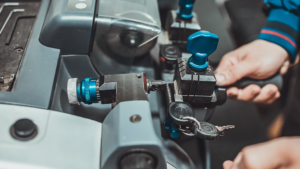Modern security practices have integrated Closed-Circuit Television (CCTV) systems as a crucial element. Whether applied in residential or commercial contexts, these systems offer a reliable way to monitor and safeguard properties. To ensure the proficient operation and optimal efficiency of your CCTV setup, consider the following pointers.
Thoughtful Camera Positioning: Thoughtful positioning of cameras is essential for capturing clear and comprehensive footage. Identify important areas to monitor, such as entry points, high-traffic zones, and vulnerable spots. Confirm cameras are mounted at appropriate heights and angles to minimize blind spots.
Embrace Panoramic Monitoring: Decide on cameras featuring wide-angle lenses or pan-and-tilt options to cover spacious regions. This minimizes camera requirements while ensuring complete coverage.
Climate Resistance: For outdoor camera installation, opt for weather-resistant models that can withstand various weather conditions. This resistance ensures uninterrupted surveillance, no matter the surroundings.
Superior Camera Integration: Integrate superior cameras with high resolution into your surveillance system to achieve impeccable image clarity and finer details. These cameras also excel in low-light environments, ensuring reliable surveillance performance.
Digital Surveillance: Opt for a CCTV system that enables remote access using a smartphone app or web browser. This functionality allows you to keep an eye on your property in real-time from any distance, amplifying convenience and security.
Optimal Lighting: Satisfactory lighting is necessary for obtaining clear recordings, especially in low-light scenarios. Reflect on situating cameras near existing light sources or using cameras equipped with infrared (IR) sensors for enhanced night vision.
Scheduled Inspections: Carry out scheduled maintenance inspections on your CCTV system, ensuring cameras are clean, aligned accurately, and operating smoothly. Dust or debris on the lens can compromise image quality.
Appropriate Recording Capacity: Verify that your CCTV system has the appropriate recording capacity for capturing footage. Depending on your circumstances, think about cloud storage or opt for an on-site digital video recorder (DVR) or network video recorder (NVR).
Privacy Adherence: Follow privacy laws and regulations when placing cameras, especially in areas that could encroach upon others’ privacy.
Fortified Network Defense: When your CCTV system connects to the internet, strengthen it with strong passwords and encryption. Keep firmware updated on a regular basis to defend against possible vulnerabilities.
Motion Sensing: Make use of motion detection configurations to activate recording and notifications upon detecting movement. This saves storage capacity and brings your focus to possibly important occurrences.
Holistic Integration Approach: Merge your CCTV system with other security measures, like alarms or access control systems, to develop a comprehensive security solution.
Secrecy Settings: If your cameras surveil areas with a blend of public and private spaces, utilize privacy settings to obscure private areas from observation.
Regular Upgrades: Ensure your CCTV system remains current by installing the latest firmware and software updates provided by the manufacturer.
Training for Effective Use: For a CCTV system accessed by several users, deliver comprehensive training to enhance their operational skills.
Legal Obligations: Become familiar with local legal requirements and directives regarding the operation of CCTV systems, especially in public spots.
Recorded Video Examination: Conduct regular assessments of captured footage to uncover any abnormal or suspicious activities. This step aids security protocols.
Redundant Power Option: Reflect on supplying backup power to your CCTV system, such as uninterruptible power supply (UPS) units. This assists in sustaining surveillance during power blackouts.
Scheduled Examination: Plan scheduled examinations of your CCTV system to ensure the functioning of all cameras and the proper recording and storage of footage.
Professional Installation: Despite the presence of DIY alternatives, professional installation ensures accurate camera placement, wiring, and setup to achieve optimal performance.
Employing these recommendations will help maintain the resilience and effectiveness of your CCTV system in enhancing security, whether for your residence, business, or any property. Keep in mind that technology is continuously progressing, so staying updated about the latest advancements in CCTV systems can enhance your security protocols.





